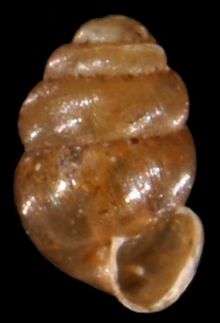Vertigo geyeri
Vertigo geyeri is a species of minute air-breathing land snail, a terrestrial pulmonate gastropod mollusc or micromollusc in the family Vertiginidae, the whorl snails. The specific name geyeri is in honor of German zoologist David Geyer (1855–1932).
| Vertigo geyeri | |
|---|---|
 | |
| Apertural view of a shell of Vertigo geyeri | |
 | |
| Six shells of Vertigo geyeri, scale bar in mm | |
| Scientific classification | |
| Kingdom: | |
| Phylum: | |
| Class: | |
| (unranked): | clade Heterobranchia clade Euthyneura clade Panpulmonata clade Eupulmonata clade Stylommatophora clade Orthurethra |
| Superfamily: | |
| Family: | |
| Subfamily: | Vertigininae |
| Tribe: | Vertiginini |
| Genus: | Vertigo |
| Subgenus: | Vertigo |
| Species: | V. geyeri |
| Binomial name | |
| Vertigo geyeri Lindholm, 1925[2] | |
| Synonyms | |
|
Vertigo geyerii Lindholm, 1925 [orth. error] | |
Description
The egg-shaped-oval shell measures just 1.7 to 1.9 mm (0.07 to 0.07 in). in length and 1.2 mm (0.05 in) in width. There are up to five whorls with deep seams. The aperture has four small protrusions (called "teeth") (on parietal one columellar and two palatal), it can also have fewer teeth. The colour of the shell is reddish-brown and the surface is shiny. The shell has regular growth striations and is almost smooth.[3][4]
Habitat
This species lives in constantly wet, calcareous flush-fens that are fed by tufa-depositing springs. In the British Isles (Ireland and United Kingdom) it often lives in association with black bog-rush Schoenus nigricans and yellow sedge Carex viridula, in dense short grasses and sedges with little Sphagnum moss.[5]
Distribution and conservation status
Vertigo geyeri is a boreo-alpine species, probably endemic to Europe. It occurs in the boreal, alpine, continental and Atlantic zones with a range extending from Ireland to Russia. Its populations are scattered and local extinctions of isolated populations can occur. It is mentioned in Annex II of the European Union's Habitats Directive.[1]
In the British Isles it is included in the List of United Kingdom Biodiversity Action Plan species, Great Britain (endangered in Great Britain).[6]. It occurs in such scattered locations as on Beinn a' Ghlò in Eastern Scotland, in North Yorkshire, in Cumbria and in Corsydd Môn in Anglesey, where there is a large, low-altitude population in a calcareous fen.[5]
It is considered critically endangered in the Czech Republic,[7][8] Its conservation status in Czech Republic in 2004-2006 is bad (U2) in report for European Commission in accordance with Habitats Directive.[9] and it occurs in Denmark, Finland, France, Germany, Latvia, Lithuania, Norway, Poland, Slovakia, Ukraine,[10] Sweden and Switzerland.[1]
References
- Killeen, I.; Moorkens, E. & Seddon, M.B. (2011). "Vertigo geyeri". IUCN Red List of Threatened Species. 2011: e.T22940A9400082. doi:10.2305/IUCN.UK.2011-2.RLTS.T22940A9400082.en.
- (in German) Lindholm W. A. 1925. Studien an palaearktischen Vertigo-Arten. Archiv für Molluskenkunde 57 (5/6): 241-251.
- "Vertigo geyeri Lindholm, 1925". AnimalBase. Retrieved 15 March 2020.
- "Vertigo (Vertigo) geyeri LINDHOLM, 1925". Uniwersytet im. Adama Mickiewicza w Poznaniu. Archived from the original on 6 March 2005. Retrieved 15 March 2020.
- "Geyer's whorl snail Vertigo geyeri". JNCC. Retrieved 15 March 2020.
- 2001–2007. Action plan for Vertigo geyeri. UK Biodiversity Action Plan, Joint Nature Conservation Committee
- "Evropsky významné lokality v České republice" (in Czech). 2003.
- "Red List of the molluscs (Mollusca) of the Czech Republic". 2006-07-14.
- (in Czech) Dušek J., Hošek M. & Kolářová J. (2007) Hodnotící zpráva o stavu z hlediska ochrany evropsky významných druhů a typů přírodních stanovišť v České republice za rok 2004-2006. - Ochrana přírody, 62(5): appendix 5:I-IV.
- Balashov I. & Gural-Sverlova N. 2012. An annotated checklist of the terrestrial molluscs of Ukraine. Journal of Conchology. 41 (1): 91-109.
| Wikimedia Commons has media related to Vertigo geyeri. |
